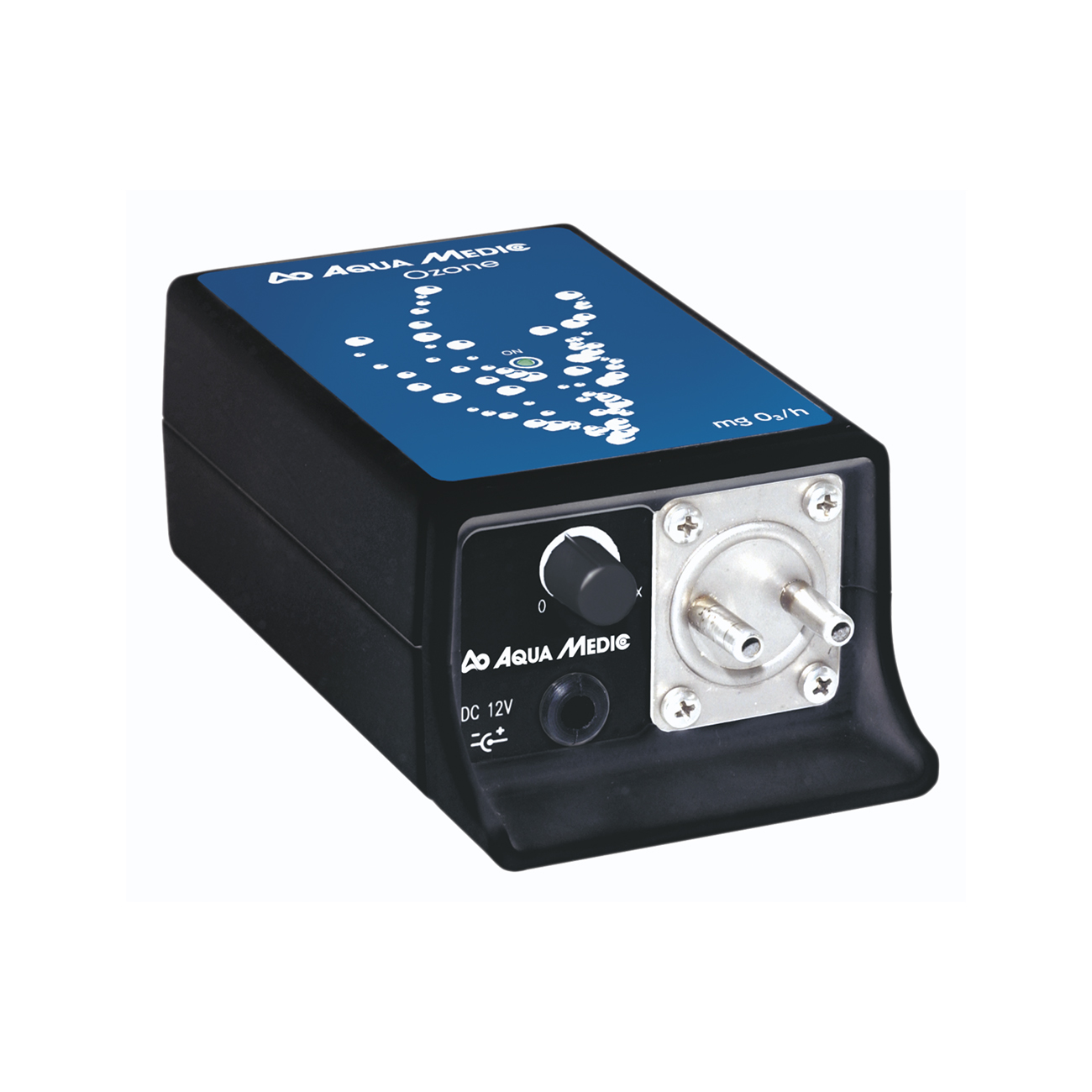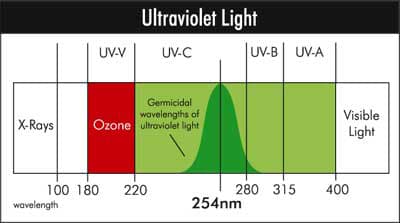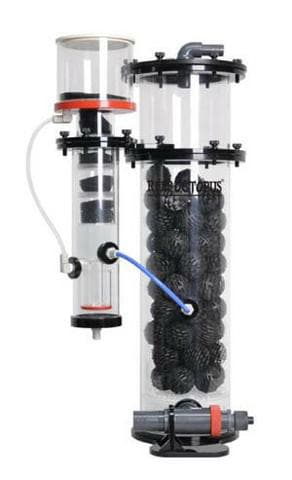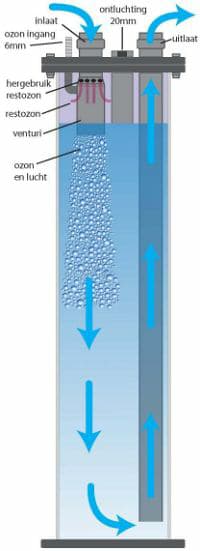To learn all that I could on the subject, I talked with Boomer William Wing, an expert reef keeper that I hold in high regard; Raj Shingadia, owner of MRC who utilizes ozone in his life support systems in public aquariums and large commercial installations; and Chad Wholer, owner of Aqua Medic USA, which makes and sells ozone units.What is ozone?
Check out this short video from Marine Depot.
Boomer: It pretty much came from Sanders of Germany, that built Ozone units for the aquarium hobby and still do. The late Albert Thiel promoted them heavily in the 90’s but they were around before him and they were really adapted from public aquariums usage. But it was Thiel that really got it going in the reef hobby.
 Two different types of ozonizers. One from Aquamaxx (one that I use) is UV Ozone generator. The one on the bottom from Aqua Medic USA is high tension transformer type, Corona Discharge that you can control.
Two different types of ozonizers. One from Aquamaxx (one that I use) is UV Ozone generator. The one on the bottom from Aqua Medic USA is high tension transformer type, Corona Discharge that you can control.
Let’s talk about the pros and cons of using ozone in reef aquariums, as well as some of the misinformation that is floating around the interweb.

Pros:
Chad: Drops/clears/oxidizes tannin, molecules, and organics in the water. Allows the organics to bond to proteins when protein skimming, in-turn pulling more organics from the water. This allows the protein skimmers to work at a much more effective rate and full potential. Raises ORP. Helps to decompose harmful nitrites.
Boomer : Whether it be skimmers, reactors, or tubing they need to be ozone-proof. You still need or should use GAC to remove any RTO or potential RTO. You should think about an Ozone controller to monitor what is going on. So, it is more of a cost thing. Of course this also means more labor intensive, a good DPD test kit to see if there are any RTO’s, cleaning the probe to stop any false high ORP readings and cleaning the Ozone unit so it is more efficient. You need to also think of a air dryer to remove any moisture. Moisture can really drop the Ozone output, which means your Ozone output settings will be to low.
Chad: Harms family if regularly and heavily inhaled. Can harm equipment that is not ozone safe. Ozone has a half-life that breaks down anything it contacts much faster. If overdosed or increased too quickly can cause damage or death to livestock.
What false information have you guys heard about ozone in reef aquariums? (like that it can kill everything in your tank and your house)
[Also], if you don’t have good fittings and if the ozone is not mixed correctly, to where any free ozone gets into the air, which you can smell, its early warning are headaches.
Chad: Not necessarily kill, but damage human/pets lungs. This may all be dependent on how much is being used and how much escapes out of the aquarium. I have heard horror stories of people blasting their aquarium with extreme doses of ozone and “crashing” the aquarium overnight (this could be false blame and/or user error).
Raj: That it’s safe and all you need is an ORP controller to ensure that. That can’t be farther from the truth. Ozone is a very powerful tool, but it’s hardly safe. You can use it safely, however. But, I think it’s important to acknowledge its destructive nature.
Why should one should consider having a unit?
Chad: Clear water makes for a prettier aquarium. Full potential of skimming with the help of ozone ultimately leads to less organics which normally break down to ammonia, nitrate, nitrite, and phosphates. The lack of organics help reduce stress on some livestock and slow or stop algal blooms.
How do you inject ozone into aquariums?
3. Ozone Reactor, by far the best but another thing to buy and most aren’t designed correctly so you are limited on choice. Matter of fact, I have only seen one correctly designed that is for public aquariums and I don’t think it is even made anymore. There used to be one where I innovated a new injection means and level controller, also not around anymore. The one for public aquariums used methods similar to mine. Properly designed reactors are expensive. It is not that you have to have a fancy one, anymore than you need a fancy skimmer. But functionality and efficiency wise a fancy Ozone Reactor outdoes a fancy skimmer.

Boomer, what are all those bioballs in the reactor? What are their purpose?
Boomer: The bioballs and pvc shavings are used to spread out the water into a thin film, which allows the ozone to do its job better. Some units in the past, that were produced for the hobby and PA, had the pvc shavings and/or bioballs replaced with industrial “fogging” nozzles. This produced a tumbling effect and mist of very fine drops. So, there was no need for a media. Some units also had automated float switches, to give a constant water level; they were either electronic or mechanical and controlled the air flow, thus the internal pressure and water level.

Let’s get back to the topic!
Raj: The most common method of ozone injection is via your protein skimmer; just make sure it’s ozone compatible. You can also use a dedicated ozone reactor, but they’re unnecessary if you have an appropriate skimmer.
Chad: It is always a good question to ask the manufacturer of their protein skimmer when setting up ozone with a protein skimmer. Are all components of the protein skimmer Ozone resistant? If not, go with another protein skimmer which is ozone resistant, or do not use ozone.
Raj: Some materials are better at resisting the effects of ozone. You want to check the ozone resistance in both water and air situations; they differ vastly.
Is ozone dangerous?
Raj: You have to realize that ozone is not only breaking down organics, it can also have chemical effects, producing toxic by-products. If your saltwater contains bromide (it does), ozone can turn it into hypobromous acid. There are many other reactions like this that can have an adverse affect on your livestock. And since your aquarium looks clean and normal water tests don’t show anything out of the ordinary, you’d never think to suspect your LSS.
What precautions should we take? Personally I didn’t think much of it and when I always have had one paired up with apex controller with ORP for security and a timer and it would run only during the time that everyone was sleeping and turned off about hour before everyone woke up as ozone dissipates in minutes and not hours and because it is heavier than regular oxygen molecules, it would sink. Was I right in this?
Chad:So long as nobody is sleeping on the floor next to the aquarium 😉
Raj: You should assess why you’re wanting to use ozone and see if that task can be accomplished by something you can better control; something safer.
- carbon. Lots of it and change it frequently.
- A timer: run your ozone during a time when nobody is at home.
- Ambient ozone monitor/controller.
- Ventilation. Evacuate the air in your LSS space.
Raj, how do you guys utilize ozone in your LSS?
There are some very specific instances where we’ll use ozone in our LSS designs. 100% of them will require safety protocols. Not only do we employ ozone destruct units to neutralize ozone, but also ambient ozone monitors. When these monitors detect ozone in the air, they will sound an alarm (visual) and shut off the ozone generator. This ensures that your LSS room or house doesn’t get engulfed with ozone(if you have an O3 leak, your ORP probe isn’t going to tell you anything).
Now there seems to be different measurements for treatment vs clarity. Can we go little bit more on this?
Chad: Aqua Medic recommends to start with 10mg of Ozone per hour for every 26 gallons. (0.384mg per gallon) This is only a starting point and a recommendations, not a concrete rule. I believe trying to define the difference of treatment vs clarity for most hobbyist will only have them chasing numbers when both treatment and clarity overlap quite a bit. Advanced hobbyists will find these differences based on their own aquariums’ requirements and techniques and can define them on their own if they choose to achieve different goals for their aquariums.
Boomer: For clarification no more than 0.3-0.5 mg / gal. But you can go much less than this, 0.1-0.2 mg/gal. The higher one is one from the past. The best ozone units have a controlled dial like a SANDER Ozonizer. Example, a 50 gal tank using a 25 mg ozone unit 0.2 x 50 = 10, so, you turn the dial on the unit to 10.These settings are more on the order of trial and error, these are just some things to start with. Without a Air Dryer these recommended levels or any recommended levels can drop a lot. Some don’t use dryers and just crank the ozone unit up. The reason for a ORP probe and a DPD test kit is so you know where you are at no matter how you do it.
What should we look for when we are trying to put one in our system?
Chad: What we are trying to achieve might be a little different than what we are looking for. We are trying to achieve an aquarium with clear water and the removal of more organics within the water column. What we should look for is both negative and positive aspects as a possible result of ozone dosing. We want to look for negative aspects so quick and calculated adjustments can be made to remove the possibility that ozone is the culprit. We also want to look for the positive aspects of a cleaner, clearer aquarium as this is the reason for adding ozone to the aquarium and should outweigh any potential problems if any at all.
Raj: You want a quality unit from a strong, reputable manufacturer and size the unit properly for your system.
Any last advice?
Boomer: When algae grows on the probe you get false high readings as they they release oxygen, oxides, superoxides, and peroxides, which raises the ORP at the probe algae interface
Please read these articles where I had a lot of input from Dr. Randy Holmes Farley. You can learn more from it than anywhere. Any questions let me know.
Some of the abbreviation that was used here.
LSS = Life Support System
OSR = Organic Savaging Resins, like SeaChem sells. They take out organics like GAC does
DPD is a test procedure that tests positive in the presence of Ozone, Chloramine, Chlorine, Bromine
DPD = is short for
N,N Diethyl-1,4 Phenylenediamine Sulfate
D from Diethyl, P from Phenyl and D from diamine
RTO = Residual Total Oxidants as in things that ozone coverts, like Bromide or Chloride to Hypochlorous or Hypbromous










0 Comments